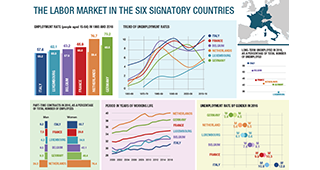In 2016, the employment rate in Italy was 57.2 percent of the working age population, a lower level than that observed in the Eu as a whole, and even lower when considering the sole founding countries. Italy's delay in labor market participation >read more
is not new: only in the 1980s the gap was reduced to less than 4 percentage points, reaching its lowest in 1984. The widest divergence was observed during the recent crisis: in these years, the gap between Italy and the Europe of the six, but also of the 28, reached the highest levels ever. Europe 2020 employment target of 75 % appeared far away.
In the decades following the founding of the European Community, the Eu-6 aggregate showed a continuing decline in gender gap in employment rates. In our country, however, a change of pace only started in the early 1970s: the percentage points that separated male and female employment rates were 50 in 1970 and fell to 18 in 2016; but, it is still far from the whole of the Eu countries and the aggregate of the six founders.
In 1963, the unemployment rate in Italy was 4 percent: a historic low, but still higher than that of the group of the six founders. A similar trend was shared by Italy and the Eu-6 until 2001. From 2004 to 2007, our country >read more
showed lower levels of unemployment than the group of founders, but this result was short-lived. With the crisis, the problems of the Italian labor market resurfaced and the unemployment rate rose again, and as early as 2008, exceeded the aggregate of the founding countries, and in 2012 the whole of the Eu. In 2014 Italy recorded the highest level of unemployment over the past 60 years.
For almost 20 years following the signing of the Treaties of Rome, labour market participation, measured by the activity rate, showed a negative trend, more pronounced in Italy than in the founding countries. Only in 2000 Italy’s >read more
activity rate returned to the level of 1960. These developments resulted in a growing gap with the Eu-6 countries, which even widened in the years of the crisis; in 2016, it exceeded 10 percentage points (they were just over 3 in 1960). The distance with the whole of the Eu, however, was less marked, but consistent (8 percentage points).
During the first 60 years of Europe, profound demographic and social changes have put “older” workers increasingly at the centre of policies. Longer life expectancy imposed longer permanence in the labor market. In Italy >read more
, the employment rate of 55-64-year-olds is lower than the European average and the one calculated on the aggregate of the founding countries. In particular, the gap with the six founders, which was 2 percentage points in 1983, has expanded over time: the growth in employment levels of this age group - which in fact started in the early 2000s – has been less intense than in the European partners.
In the early 1980s, the gap between the male and female employment rate in the 55-64 age group was really large, particularly in Italy. This difference , which has been attenuated since the 1990s, kept the Italian situation away from that of the six founders, who have seen a dramatic reduction in gender disparities.
Since the 1980s the share of wages, that is, the percentage of income for dependent work (corrected to take account of differences in job composition) has decreased in all the founding countries, and even more in Italy. Since it is an anti-cyclical indicator >read more
- in the early stages of the crisis, the share of capital gains tended to decrease more than labor income – there was a recovery in 2008-2010, which only temporarily interrupted the historical deterioration of the labor share on Gdp.


